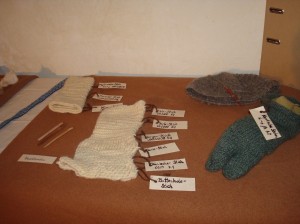Naalbinding
Naalbinding (or coptic knitting, nailbinding) is a texitle technique which is the predecessor of knitting.
The technique is using an 8-12 cm long needle from wood, bone or horn and in most cases a double-twined wool yarn (z-spun, s-twined). Other yarns work as well, but in most cases they are from wool that can be felted. Naalbinding, compaired to knitting is based on a closed knotwork instead of loops from an endless thread. Therefor the wool needs to be felted together at the end of each piece of yarn. The textiles made in Naalbinding technique are more durable than knitware since they will not disolve when one thread is broken.
First finds reach as far back as 6.500 BC in Israel, 4.200 BC in Denmark.
With the invention of knitting, which allows a faster build up of textiles, in the 13th and 14th century Naalbinding lost it’s dominant role, yet it has been kept a tradition in different nordic countries of Europe until today.
While in the Early Medieval in northern Europe, the technique was widely spread among the common people, findings in middle Europe could only be made in ecclesiastic contexts which makes it hard to prove the use of Naalbinding for socks, mittens and other textiles in our region.
Among findings are also bonnets, bags, milk sieves and in some cases seam decorations.
Some of the findings:
- Coptic socks (4.-6. C. AD)
- Coppergate Socks, York – England (970. AD)
- Mittens, Lund, Sweden (12.C AD)
- Socks, Uppsalla, Sweden (12. C AD)
- Socks, Delsberg, Swiss (12. C AD)
- Mitten, Schleswig, Germany (13.-15. C AD.)
- Bonnet of St. Symeon (Trier, Germany, before 1035)
- Pontifical gloves of Bernardo degli Ubert, Florenz Italy (13. C AD)
- Pontifical gloves of Peter of Courpalay (ca. 1334, France)
The stitches:
- Buttonholestitch ( F1 B1 -/-O)
- Danish Stitch (F1 O/UO)
- Coptic Stitch/Tarimsstitch
- Oslo Stitch (F1 UO/UOO)
- Mammen Stitch ( F2 UOO/UUOO)/ Korgen Stich (F1 UOO/UUOO)
- York Stitch (F1 oder F2 UU/OOO)
- Brodén’s Stitch (F1 oder F2 UOOO/UUUOO)
- Dalby Stitch (F1 UOU/OUOO)
- Coppergate Stitch/ York Stitch (F2 UU/OOO)
- Saltdal Stitch (F1 oder B1) UUU/OOOU)
- Åsle Stitch (B1 F1 U(U)O/UO:UOO)
- Omani Stitch (F1 U(U)(OO/UU)OOO:UUUOO)
- Müsenstitch (Mid2 UOO/UUOO)
- Finnish Stitch (F2 UUOO/UUOOO F2)






